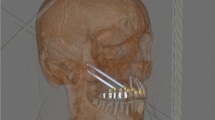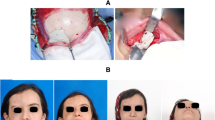Abstract
Introduction
Patients affected with mucormycosis of maxilla have been increasing following Covid-19 infections. We followed the reconstruction of the maxilla using 3D manufactured patient-specific implants. The additive manufacturing technology is capable of fabricating custom-made titanium implants precisely for oral and maxillofacial reconstructions.
Aim
To analyse the effectiveness of 3D manufactured patient-specific implants in the reconstruction of maxilla affected by mucormycosis secondary to Covid-19. Methodology: This study was conducted among 20 patients receiving patient-specific implants for surgical and prosthetic reconstruction of the maxilla. The parameters analysed at baseline, 3 months, 6 months, and 12 months were pain, implant exposure, infection, wound dehiscence, fit of implant, postoperative surgical rating scale, and patient experience evaluation rating scale.
Results
Inferential Statistics revealed a positive correlation.
Conclusion
From the present data, it can be concluded that within the limitations of the study, patient-specific implant systems are an effective treatment strategy for the reconstruction of the maxilla affected by mucormycosis secondary to Covid-19. More studies with larger sample size and longer follow-up periods are required to substantiate the results from the present study.


Similar content being viewed by others
References
Spagnuolo G, De Vito D, Rengo S, Tatullo M (2020) COVID-19 outbreak: an overview on dentistry. Int J Environ Res Public Health 17(6):2094
Amod G, Aman S, Arunaloke C (2021) The emergence of post-COVID-19 mucormycosis in India: can we prevent it? Indian J Ophthalmol 69(7):1645–1647
Meher R, Wadhwa V, Kumar V, Shisha Phanbuh D, Sharma R, Singh I, Rathore PK, Goel R, Arora R, Garg S, Kumar S, Kumar J, Agarwal M, Singh M, Khurana N, Sagar T, Manchanda V, Saxena S (2022) COVID associated mucormycosis: a preliminary study from a dedicated COVID Hospital in Delhi. Am J Otolaryngol 43(1):103220
Gopal A, Sharma R, Negi S et al (2022) Post-COVID Mucormycosis of mandible: a conundrum of management. Cureus 14(7):e27382
Arun Kumar J, Babu P, Prabu K, Kumar P (2013) Mucormycosis in maxilla: Rehabilitation of facial defects using interim removable prostheses: a clinical case report. J Pharm Bioallied Sci 5(Suppl 2):S163–S165
Manmadhachary A, KumarMS, Ravi Kumar Y, Haranadha Reddy M, Adityamohan A, (2017) Design & manufacturing of implant for reconstructive surgery: a case study. In: The international conference on design and technology, KEG, pp 143–149
Ghantous Y, Nashef A, Mohanna A, Abu-El-naaj I (2020) Three-dimensional technology applications in maxillofacial reconstructive surgery: current surgical implications. Nanomaterials 10(12):2523
Truscott A, Zamani R, Akrami M (2022) Comparing the use of conventional and three-dimensional printing (3DP) in mandibular reconstruction. BioMed Eng OnLine 21:18
Arafat Y, Kumar YN, Bharani K et al (2021) COVID-19-related mucormycotic osteomyelitis of the Maxilla: a case report of findings, surgical management and post-surgical rehabilitation. World J Dent 12(5):423–426
Kim MM, Boahene KD (2009) Byrne PJ Use of customized polyetheretherketone (PEEK) implants in the reconstruction of complete maxillofacial defects. Arch Facial Plast Surg 11(1):53–57
Owusu JA, Boahene K (2015) Update of patient-specific maxillofacial implant. Curr Opin Otolaryngol Head Neck Surg 23(4):261–264
Mamoru MJC, Paulo B, Dirk F, Albert JS, Kamlakar R, Naohiko S (2013) Bio-manufacturing. CIRPAnn Manuf Technol 62:585–606. https://doi.org/10.1016/j.cirp.2013.05.001
Elisabet FG, Jan W, Jenneke KN (2015) Application of additive manufacturing in oral and maxillofacial surgery. J Oral Maxillofac Surg 73(12):2408–18
Kaushik AS, Balaji T, Alwala AM (2022) Design, analysis, and fabrication of patient-specific implant for maxillofacial surgery. Adv Mater Sci Eng 6(6):1–13
Grecchi F, Zecca PA, Macchi A, Mangano A, Riva F, Grecchi E, Mangano C (2020) Full-digital workflow for fabricating a custom-made direct metal laser sintering (DMLS) mandibular implant: a case report. Int J Environ Res Public Health 17(8):2693
Zoabi Adeeb et al (2022) 3D printing and virtual surgical planning in oral and maxillofacial surgery. J Clin Med 11(9):2385
Ghantous Y, Nashef A, Mohanna A, Abu-El-Naaj I (2020) Three-Dimensional technology applications in maxillofacial reconstructive surgery: current surgical implications. Nanomaterials (Basel) 10(12):2523
Truscott A, Zamani R, Akrami M (2022) Comparing the use of conventional and three-dimensional printing (3DP) in mandibular reconstruction. BioMed Eng OnLine 21:18
Funding
Not applicable.
Author information
Authors and Affiliations
Corresponding author
Ethics declarations
Conflict of interest
None.
Additional information
Publisher's Note
Springer Nature remains neutral with regard to jurisdictional claims in published maps and institutional affiliations.
Supplementary Information
Below is the link to the electronic supplementary material.
Rights and permissions
Springer Nature or its licensor (e.g. a society or other partner) holds exclusive rights to this article under a publishing agreement with the author(s) or other rightsholder(s); author self-archiving of the accepted manuscript version of this article is solely governed by the terms of such publishing agreement and applicable law.
About this article
Cite this article
Alwala, A.M., Ramesh, K., Swayampakula, H. et al. Analysis of the Effectiveness of 3D Printed Patient-Specific Implants for Reconstruction of Maxillary Defect Secondary to Mucormycosis. J. Maxillofac. Oral Surg. 22, 728–733 (2023). https://doi.org/10.1007/s12663-023-01922-7
Received:
Accepted:
Published:
Issue Date:
DOI: https://doi.org/10.1007/s12663-023-01922-7




